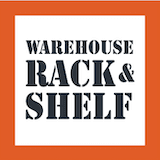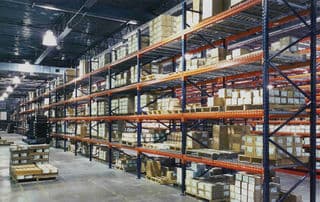The Rack Manufacturers Institute (RMI) has specific testing requirements for pallet rack and wire decking. Most of the larger pallet rack & wire decking manufacturer’s are members of RMI. If you are buying a product and it has the “R-Mark” it tells you that the product has been quality tested. The pallet rack and wire decking that Warehouse Rack & Shelf LLC sells have been manufactured to RMI specifications.
There are some things to consider when you select, install, use and maintain your pallet rack system: Before buying rack you should analyze the volume of activity and number of SKU’s in your warehouse to determine the appropriate amount of rack. Choose a rack layout that best suits your building and requirements. Try to design the rack layout to reduce steps and increase efficiency. Develop a rack elevation which shows number of beam levels and spacing of beam levels. Develop a bill of material (B.O.M) with quantity and sizes of upright frames and beams. Match your forklift trucks to best service your rack. Buy the proper equipment and make sure that your forklift operators have the proper required training. This will also help minimize the chance of rack damage. Buy pallet rack and wire decking that has the “R-Mark” and has been designed and manufactured to the Rack Manufacturers Institute specifications. Contact your local building officials to find out what they require. They may require that you pull a permit. Follow all building codes and seismic requirements.
Is it okay to mix rack types? You must check with both manufacturers to verify rack dimensions before you can insure compatibility. Mixing rack can lead to potential problems. Even 1/4″ difference in beam length can prevent beams from being compatible with existing rack when trying to fit into existing rack row. Even upright frame widths can vary and prevent you from replacing uprights in existing row. When in doubt, don’t mix.
Have your rack installed by an experienced and insured rack installer. Determine if a union or non-union rack installation is required in your new building. Make sure that the floors are level and plumb. Purchase proper anchors and shims. Make sure beams are properly connected with working autolocks to secure beams to uprights.
Here are some other suggestions:
Post rack capacity signage. Do not overload racks. Know the capacity and size limitations of your rack.
Have proper lighting that is designed and configured around your rack layout.
Purchase rack reinforcement and protection including column protectors, post protectors and end of aisle protectors to help reduce rack damage.
Regular maintenance of your rack includes repair or replacement of damaged components. Damage uprights and beams can lead to a dangerous rack failure. Immediately replace rack that is damage by forklifts. Replace damaged beams & damaged beam locking devices. Conduct regular inspection routines.
Concentrate on load containment. Avoid unstable loads by shrink wrapping your pallet loads.
Add wire decking on your rack to give better support to your pallet loads. Buy quality pallets that are designed to support your load and fit your rack. Better yet, buy your rack to properly support your pallet loads.
Follow general safety considerations. Never allow employee’s to climb on racks. Prevent overloading of racks. Be aware of unsafe practices or conditions within your facility.
Provide fall protection where appropriate. Consider pallet load stops beams, back stops, safety netting, rack guard panels or fencing on your rack. Provide overhead protection (wire decking) for storage levels or areas above work stations, pick tunnels, rack tunnels and drive through tunnel bays. Always make tunnel bays interior bays.
Provide regular professionally planned inspections, routine maintenance and training.
Follow all OSHA regulations. For more information please visit: http://www.mhia.org/psc/PSC_Products_racks_TechnicalPapers.cfm

